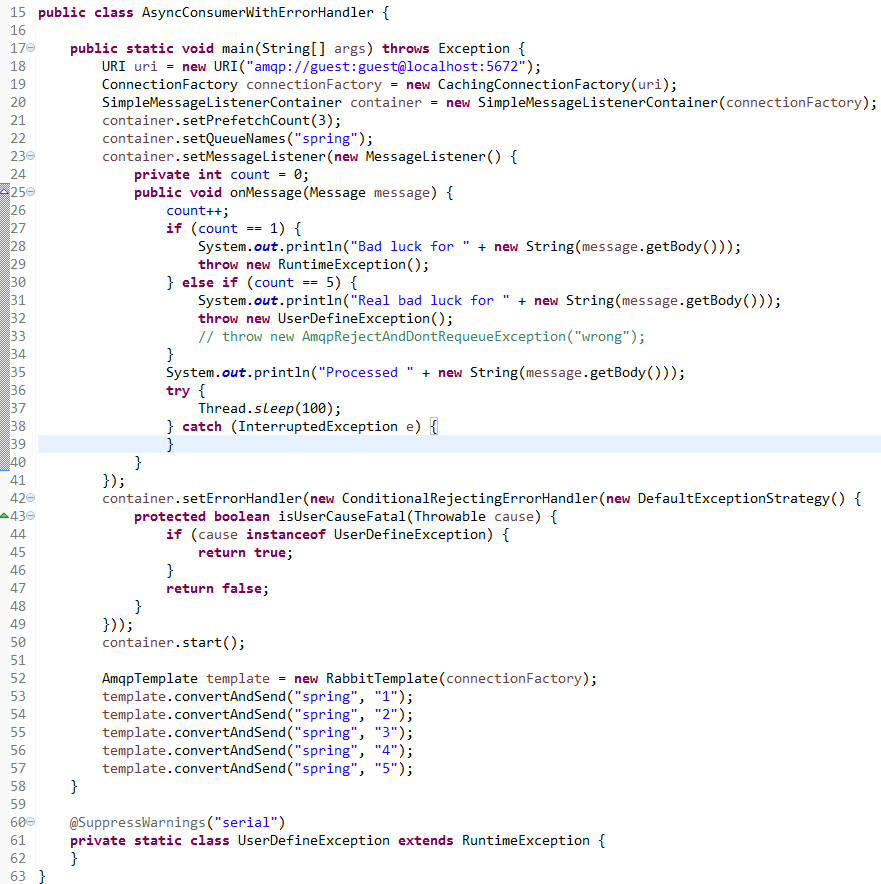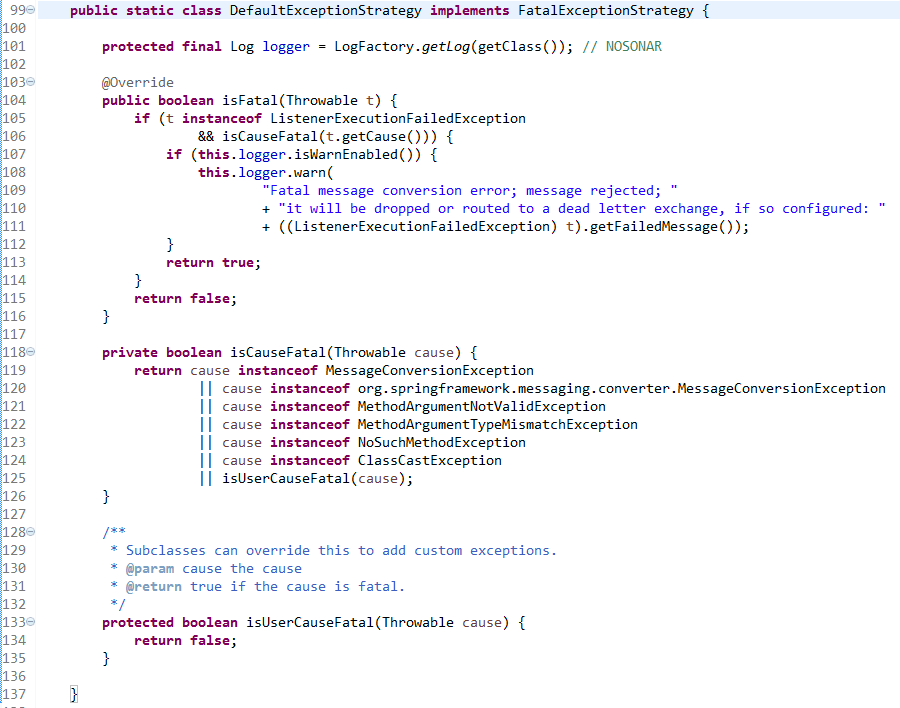### 准备
## 目标
了解 Spring AMQP Message Listener 如何处理异常
## 前置知识
《Spring AMQP 源码分析 04 - MessageListener》
## 相关资源
Offical doc:<http://docs.spring.io/spring-amqp/docs/1.7.3.RELEASE/reference/html/_reference.html#exception-handling>
Sample code:<https://github.com/gordonklg/study>,rabbitmq module
源码版本:Spring AMQP 1.7.3.RELEASE
## 测试代码
gordon.study.rabbitmq.springamqp.AsyncConsumerWithErrorHandler.java

### 分析
## 消息消费异常处理流程
根据上一遍文章的分析,示例代码 AsyncConsumerWithErrorHandler 第26行开始消费消息,方法运行在 AsyncMessageProcessingConsumer 线程实例中,调用栈如下:

由 AbstractMessageListenerContainer 的 doInvokeListener 方法直接发起对 onMessage 方法的调用,代码如下:

对于 onMessage 消息处理过程中抛出的异常, wrapToListenerExecutionFailedExceptionIfNeeded 方法将所有非 ListenerExecutionFailedException 异常包装为 ListenerExecutionFailedException 异常(通过 instanceof 判断,因此 ListenerExecutionFailedException 子类不会被包装),并重新抛出。
调用栈一直退出,直到 SimpleMessageListenerContainer(AbstractMessageListenerContainer).executeListener(Channel, Message) line: 729

handleListenerException 方法最终调用 invokeErrorHandler 方法,通过属性 ErrorHandler errorHandler 的 handleError 方法正式处理异常。


这是判断原因链中是否包含 AmqpRejectAndDontRequeueException 的代码:

默认情况下, exceptionStrategy 是 DefaultExceptionStrategy 的实例:

只有 ListenerExecutionFailedException 异常及其子类才可能是 fatal,但是对于本次调用栈,wrapToListenerExecutionFailedExceptionIfNeeded 方法保证了抛出的异常是 ListenerExecutionFailedException。
isCauseFatal 方法定义了一些严重异常,很显然,这些异常都是些无论重试多少次都会出错的异常,因此应该被包装为 AmqpRejectAndDontRequeueException 异常。
DefaultExceptionStrategy 预留了 isUserCauseFatal 方法给用户扩展。
异常继续往外抛,到 SimpleMessageListenerContainer.doReceiveAndExecute(BlockingQueueConsumer) line: 1260,会调用 BlockingQueueConsumer 的 rollbackOnExceptionIfNecessary 方法。该方法先判断是否要向 RabbitMQ 确认消息,如果需要确认(意味着要调用 channel 的 basicReject 方法),再根据异常的原因链中是否存在 AmqpRejectAndDontRequeueException 异常决定如何设置 basicReject 方法的 requeue 参数。
## 示例代码分析
从流程分析中可知,onMessage 方法如果抛出异常,一般情况下会导致消息被 reject,同时重新入队。这个默认设置比较安全。
如果我们不想要消息重新入队呢?最简单的方法就是抛出 AmqpRejectAndDontRequeueException,就像示例代码中被注释掉的第33行代码那样。但是这导致业务消费逻辑与框架实现绑定过深,因此,我们采用重载 DefaultExceptionStrategy 的 isUserCauseFatal 方法来决定不同的业务异常要不要让 reject 的消息重新入队,正如示例代码第42行所示。当异常类型是 UserDefineException 时,消息被 reject 同时不会重入队列。